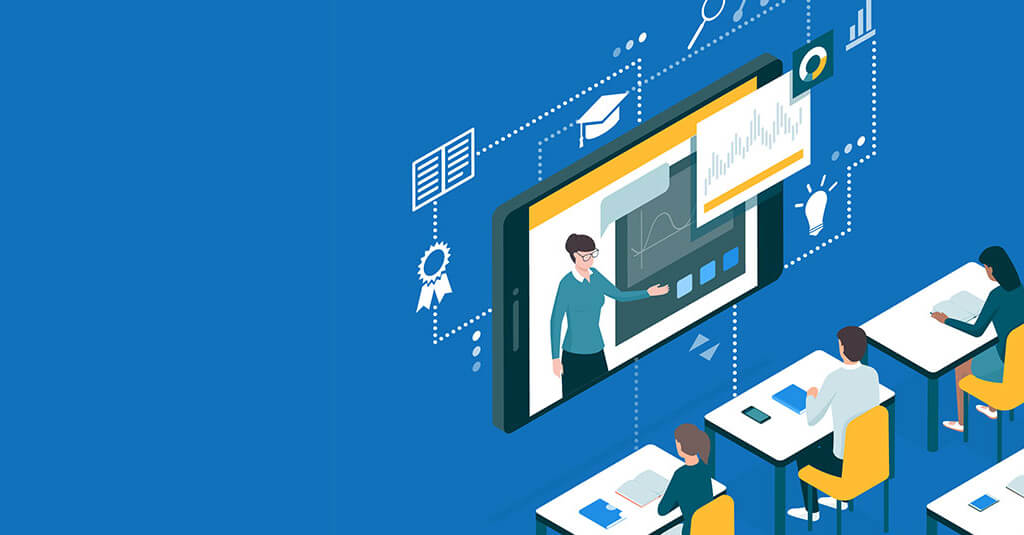eLearning is nothing but the use of technology to connect teachers and students who are physically miles apart. The training can be delivered by a number of means. In the past, these have included the use of mainframe computers, floppy diskettes, multimedia CD-ROMs, and interactive videodisks. Most recently, Web technology (both Internet and Intranet delivery) are being used.
Future trends are looking at training delivered on PDA’s and cell phones. This new, form of education is called, mLearning or mobile learning.
It is especially useful for organizations that operate from multiple offices and require a training solution that connects people at all locations, at any time and provides a standardized set of instructions and e-Learning to foster ‘enterprise transformation’ and enhance ROI. This could mean helping executives in gaining new competencies, launching new products or services or enhancing skill sets. The additional revenue generated or the return on investment (ROI) is used as the metric to measure the success of e-Learning in such organizations.
Different types of e- Learning
There are fundamentally two types of e-Learning:
Synchronous training
Asynchronous training
1. Synchronous, means “at the same time,” involves the interaction of participants with an instructor via the Web in real-time. For example – VCRs or Virtual classrooms are nothing else but real classrooms online. Participants interact with each other and instructors through instant messaging, chat, audio and video conferencing etc and what’s more all the sessions can be recorded and played back. Its benefits are:
- Ability to log or track learning activities.
- Continuous monitoring and correction is possible
- Possibilities of global connectivity and collaboration opportunities among learners.
- Ability to personalise the training for each learner.
2. Asynchronous, which means “not at the same time,” allows the participants to complete the WBT (Web-based training) at their own pace, without live interaction with the instructor. Basically, it is information that is accessible on a self-help basis, 24/7. The advantage is that this kind of e-Learning offers the learners the information they need whenever they need it. It also has interaction amongst participants through message boards, bulletin boards and discussion forums. These include computer based training,(CBTs) modules on CD-Rom’s, Web based training accessed through intranet (WBTs) or through well written articles and other write ups. Its advantages are:-
- Available ‘just in time’ for instant learning and reference.
- Flexibility of access from anywhere at anytime.
- Ability to simultaneously reach an unlimited number of employees.
- Uniformity of content and one time cost of production.
A new form of learning known as blended learning is emerging. As the name suggests it is an amalgamation of synchronous and asynchronous learning methods. Using both online training through virtual classrooms and also giving CD’s and study material for self study is now being increasingly preferred over any single type of training.
What form of e-Learning is right for me?
Asynchronous methods are used in different situations, mainly when:
- The topics are generic business topics like management training, financial training, or time management etc that are not specific to a certain organisation or process. In such cases, asynchronuous training is useful and cost effective.
- Traditional e-Learning courses through pre-recorded CD’s and write ups are used on projects with large budgets and long lead times, like a major product release.
Projects that need extensive simulations like industrial control systems; flight simulators etc are good candidates for asynchronous techniques where virtual classroom teaching is not required. - Also, training which has a long shelf life – like an organization’s profile and introduction may be a good situation to use asynchronous e-Learning.
- Due to the high production cost of traditional e-Learning, ie making audio-visual content, CDs, Presentations etc, it is expensive to change content continually therefore it is best suited for training material that is static.
- Also, Process-based training is best handled through the asynchronous method where the learner gets pre-recorded study material that he studies at his own time and can post his queries to message boards, bulletin boards, discussion sited, seminars etc
The clear advantage of a self-paced course is convenience. Participants can get the training they need at any time allowing for a greater degree of flexibility.
Synchronous e-Learning ( Virtual Classrooms)
This type of e-Learning is essentially required in some cases where traditional methods will not deliver the desired goals, like:-
- Instructor-based online mentoring is best suited for students , who need concept –based training and help with their regular studies.There needs to a constant interaction between the teacher and taught to clear doubts and make them understand complex concepts through examples and clarification of doubts.
- It is being successfully used in soft-skill training in interpersonal skills, diversity and teaching foreign languages.
Blended learning is seen by many as a process in which appropriate e-Learning modules are a precursor to a training session in the classroom i.e both the methods are successfully used in training.








